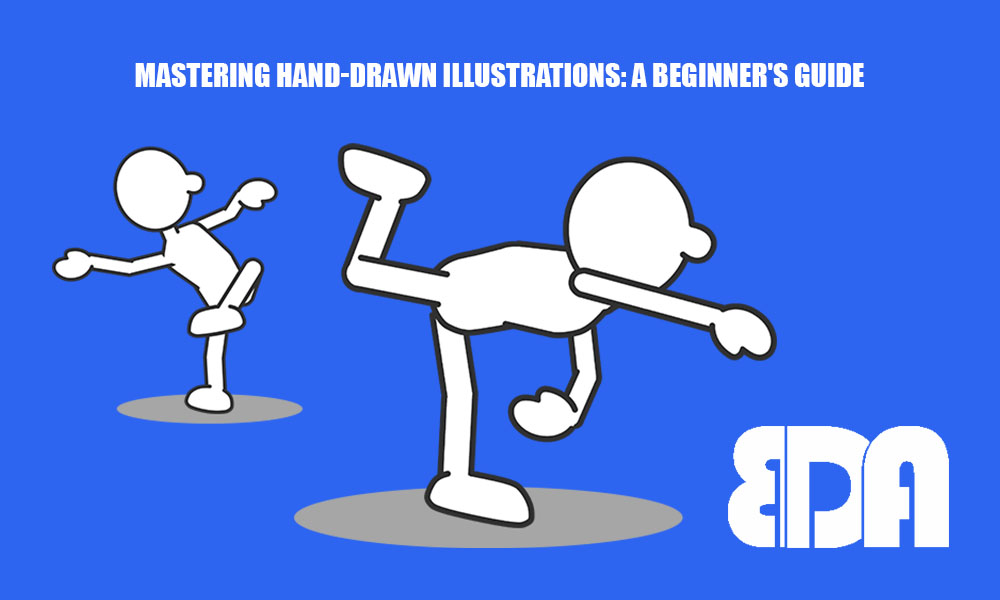Introduction to Hand-Drawn Illustrations
What constitutes hand-drawn illustrations?
Pieces of art known as hand-drawn illustrations are made manually with traditional tools such as pencils, pens, markers, or brushes. In contrast to digital art, which relies on software for execution, hand-drawn art necessitates a personal touch and direct engagement with the medium. Every work is uniquely expressive, as each stroke, smudge, and line reflects the artist’s mood and intent.
This form of art has been around for hundreds of years and continues to be widely valued today. Whether sketching lifelike portraits or crafting playful doodles, hand-drawn illustrations provide artists with a medium for genuine and unrefined creative expression. They can often be found in books, posters, greeting cards, animations, and even on product packaging, providing a humanized charm that digital art sometimes lacks.
What are the advantages of opting for hand-drawn instead of digital?
Though digital illustration is certainly well-liked, hand-drawn illustrations provide multiple benefits—particularly for novices. To begin with, manual drawing reinforces basic skills. When you sketch on paper, the temptation to hit “undo” is reduced and you are more inclined to learn from your mistakes.
Furthermore, it enhances hand-eye coordination and improves observational skills. It has a tactile quality, is personal, and can be more meditative. Moreover, starting out with traditional tools is cheaper than purchasing a tablet and software. The process itself is, for many, profoundly gratifying—experiencing the feel of paper, the resistance of a pencil, and the pleasure of seeing a completed sketch are things that digital mediums cannot reproduce.
Basic Tools and Supplies for Novices
Essential Drawing Supplies
To begin with hand-drawn illustration, you don’t need to spend a lot of money. Here is a fundamental list of tools that every novice should possess:
Pencils: Begin with an assortment of graphite pencils (e.g., 2H, HB, 2B, 4B). While fine lines and details are best served by hard pencils (H), soft pencils (B) produce darker, more intense strokes.
Erasers: It is crucial to have a kneaded eraser. It doesn’t merely eliminate; It picks up graphite softly, without harming the paper.
Paper: Opt for sketch paper or drawing pads of medium weight. Seek out paper that has some tooth (texture) to grip the pencil effectively.
Pens and Inks: When you feel at ease, utilize fineliners or brush pens for outlining and inking. Beginner-friendly brands include Micron and Faber-Castell.
Ruler and Compass: For geometric figures, symmetry, or technical drawings
Tools that are optional but helpful
Blending Stumps or Tortillons: Perfect for evening out graphite and forming gradients.
Fixative Spray: Stops smudging on completed pencil or charcoal artworks.
Lightbox: Excellent for tracing or polishing rough drafts.
Colored Pencils or Watercolors: When you feel assured, try out some color to infuse your work with energy and layers.
Making an investment in a select number of high-quality tools can greatly affect your advancement. The focus is more on mastering the use of each tool than on quantity.
Laying the Groundwork: Fundamental Drawing Methods
Grasping Lines and Shapes All aspects of drawing begin with lines. Whether straight, curved, thick, or thin, lines form shapes, delineate structures, and direct the viewer’s gaze. Start with practicing:
Contour lines: They delineate the outer boundary of objects.
Gesture lines: Rapid and expressive strokes that depict movement or position.
Cross-contour lines: These adhere to the shape of an object, providing a 3D effect.
Then, simplify complex objects into fundamental shapes: circles, squares, rectangles, and triangles. As an illustration, a human head initially takes the form of an oval. Learning to view the world through shapes aids in simplifying drawing and enhances accuracy.
Practicing Textures and Shading
After you’re at ease with shapes, advance to shading. Shading contributes to dimensionality and realism. Commence with these fundamental methods:
Hatching: Lines oriented in a single direction.
Cross-hatching: Lines that intersect at angles and overlap.
Stippling: Value is created through the placement of dots.
Blending: Utilize your pencil or blending tools to create smooth gradients.
It is essential to comprehend light and shadow. Examine the way light strikes an object and practice replicating highlights, mid-tones, and shadows. There is no need to hurry—becoming a master takes time, and practice is the only shortcut.
Creating Your Distinctive Style
Finding Inspiration Developing a style takes time. It develops through exposure, experimentation, and practice. Begin with watching how others do their work. Follow illustrators on social media, explore graphic novels, or check out art museums. Pose the following question to yourself:
Which styles do I connect with?
Is my preference for detailed realism or for playful cartoons?
Which subjects attract me—people, nature, architecture?
Visually mapping your interests and style inspirations can be aided by creating a mood board or a Pinterest collection.
Fusing Influences with Individuality
It’s perfectly fine to start with imitation—many renowned artists began their careers this way. However, don’t merely replicate—analyze. Attempt to grasp how an artist achieved specific effects, and then practice adding those methods into your own sketches.
Slowly incorporate those influences with your distinctive viewpoint. You might adore manga eyes but favor vintage color schemes. You might appreciate linework that’s not perfectly precise but like to incorporate gentle, pastel shades. This amalgamation becomes your trademark style—a voice that embodies who you are and resonates with your audience.
Regular Practice and Consistency
Establishing a Daily Drawing Habit The most effective method for improvement is to draw daily, even if just for 10-15 minutes. Here’s how you can ensure it sticks:
Choose a time: Morning, lunchtime, or evening—opt for a regular slot.
Establish a Space: Maintain easy access to your tools and ensure your environment is motivating.
Begin with small things: quick drawings, warm-up doodles, or prompts for 30 days.
Monitor Advancement: Put dates on your sketches to assess development across time.
It is more crucial to be consistent than to last for a long time. Daily practice, even if it is short, accumulates and develops your skills at an exponential rate.
Maintaining a Sketchbook for Development A sketchbook serves as a visual diary. It is a space for exploration, experimentation, and self-expression without constraints. There’s no need to worry about perfecting every page. Utilize it to experiment with new techniques, jot down ideas, or just doodle for enjoyment.
Reflecting on old pages serves as a strong motivator—you will notice the extent of your growth. And keep in mind that your sketchbook belongs only to you. Fill it with whatever energizes you. As time goes on, it turns into a rich source of inspiration and personal development.




